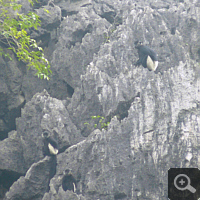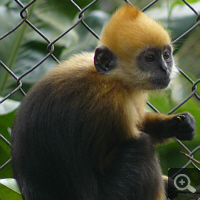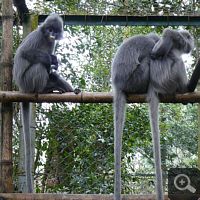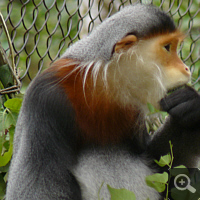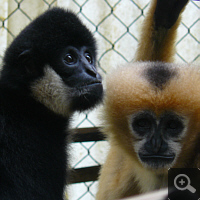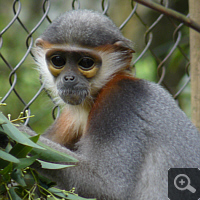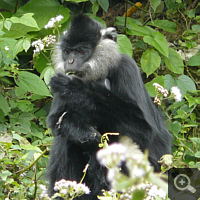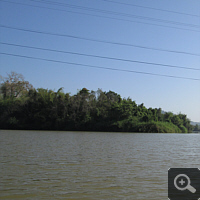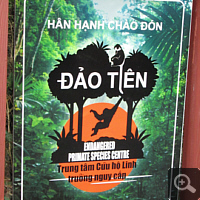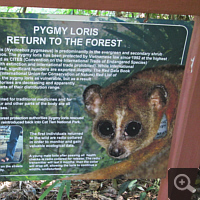Endangered monkeys of Vietnam
Some populations are literally eaten by humans.

Introduction
I am on the road with a scooter on the Vietnamese peninsula Son Tra. Out of the blue I discover a small family of red-shanked doucs (Pygathrix nemaeus) – a wonderful piece of luck.
In the treetops they put appreciatively one by one leaf into theirs mouth. But after some minutes they are tired of me and decide on going. Firstly it goes from tree to tree, but then forest comes at a scarp to an abrupt end and proceeds only after some metres markedly deeper. The male takes a run-up and jumps. Calm, with ahead strechted arms he hurtles through the air and touches down safe on the next tree. Now is the junior next. Also he takes a run-up and jumps. On the contrary, he flails in the air with arms and legs and snatches only just the next branchlet …
After wars and the political isolation for decades inhibited research, primates of Indochina came into focus of scientists not until the early 90s.
In the meantime 25 monkey species are described in Vietnam. Some were believed to be already extinct and were retrieved not until the last twenty years.
So for example the extreme rare Delacour’s langur (Trachypithecus delacouri), which was rediscovered 1992 on an expedition under the control of Jörg Adler – director of the Allwetterzoo – in the rugged karst rainforest of Cuc Phuong National Park. Likewise 1992 was rediscovered the Tonkin snub-nosed monkey (Rhinopithecus avunculus), which admittedly already 1912 in North Vietnam described, but since then was studied only on the basis of taxidermied museum specimens.
By now were numerous population researches performed and more detailed knowledge about endangerment situation and biotope collected.
Although quite recently found again, several species are again right before extinction. Seven species are regarded as ‚Critically Endangered‘, nine as ‚Endangered‘.
Primates of Vietnam
With in total 25 taxa (species and subspecies) Vietnam has the highest number of primate taxa of the countries located on the Southeast Asian mainland. Nevertheless this diversity of species is severely endangered: . Five of the species are endemic to Vietnam, and they are also listed among the 25 world’s most endangered primates. The IUCN Red List lists 7 taxa as ‚Critically Endangered‘, 9 taxa as ‚Endangered‘, 7 taxa as ‚Vulnerable‘ and only 2 taxa as ‚Least Concern‘.
Following I present these 25 species:
Lori
Lorises are nocturnal and tree dwelling primates. They are relatively small and slow moving. During the day they sleep rolled up to a ball in dense vegetation und during the night they search for food. They feed mainly on insects and fruits. Due to their nocturnality is only few known about their living, distribution and endangerment. Two species of lorises are found in Vietnam:
Macaques
Diurnal Macaques are a common and widespread primate genus of least concern. They spend time both in the trees and on the ground. Macaques feed on a wide variety on foods such as fruits, nuts, seeds, bark, leaves and also insects, small animals and eggs. Five species are found in Vietnam.
Langurs
In Vietnam can be found several different leaf-eating monkey species from the group of lutungs. They are diurnal and feed predominantly on leaves. All species are threatened and some are considered as ‚Critically Endangered‘.
Douc langurs
The diurnal doucs are relatively great, herbivorous primates found only in Indochina west of Mekong River (Vietnam, Laos and Cambodia).
Not until the end of the nineties only two douc species were known: The in Cambodia and South Vietnam occurring Black-shanked douc langur (Pygathrix nigripes) and the Red-shanked douc langur (Pygathrix nemaeus), which is found in North resp. Central Vietnam, Laos and Cambodia. As late as 1997 was a third, thus far unknown douc species discovered by employees of the EPRC. For a long time it was doubtful, whether these grey-shanked animals concern an own species. In the end doubts were cleared up by a DNA analysis and these animals described as Grey-shanked douc langur (Pygathrix cinerea).
All three species are threatened with extinction caused by humans and desperate for sustainable protective measures.
Snub-nosed monkeys
There are only five species of snub-nosed monkeys. Three of them occur in the mountains of southern China and each one in North Myanmar and Vietnam. The diet of these monkeys largely consists of leaves and fruit.
Gibbons
Who has ever experienced – like me – a gibbon group in the morning hours, the will be enthusiastic. After all it is a very musical monkey genus. The choral, melodious singings are already to hear from good distance.
Gibbons are the sole in Vietnam occurring apes. There is the genus represented with five species in total, that all are critically endangered. But in contrast to the other Vietnamese monkey species they are hardly hunted due to their meat. Instead bother them increasing loss of their habitats and a keeping of gibbon babies as pets.
The diurnal gibbons feed mainly on fruit, flowers, and shoots, but also insects, bird eggs and young birds. With their long arms and legs they are perfectly adapted for a life in canopy. Beacause they stay nearly always in canopy, they are extremely difficult to observe and to follow. Thus is not very much known yet about their distribution, population size and way of life.
Cuc Phuong National Park & EPRC
Overview
The approximately 100 km south of Hanoi located Cuc Phuong National Park was opened 1962 as Vietnam’s first National Park. With 222 km² it is today the sixth largest National Park of the country. In bottomland of the Red River (Song Hong) located topography of the park is characterized by limestone cliffs, that are primarily covered by tropical rainforest. Park became famous, after here 1992 the already assumed to be extinct Delacour’s langurs were rediscovered.
For their protection was at the park’s entrance the Endangered Primate Rescue Center (EPRC) founded, that has in the meantime rendered outstanding services to the protection of the Vietnamese primates. The EPRC is financed by the Zoo Leipzig, entrance fees and donations. In the last few years followed EPRC a centre for protection of the Vietnamese turtles (Turtle Conservation Center), that face likewise extinction, as well as a centre for small carnivore species and pangolins (Carnivore & Pangolin Conservation Program).
These centres can be visited just as the park all-season. In addition to diverse day trips you can also undertake multi-day explorations in the park. An overnight stay within the park, for example as ‚homestay‘ at the native Muongs, is possible.
Cuc Phuong National Park
The National Park is considered to be very species-rich. In the forests were 89 mammal, 110 reptile, 65 fish and 320 bird species proven. However, first and foremost Cuc Phuong is famous for its extreme abundance of insects (about 1.800 species) and the Delacour’s langurs.
Between early March and early May squillions of butterflies metamorphose the park into a colourful sea of blossoms. Admittedly, the extreme rare Delacour’s langurs were rediscovered here first, but are almost not to observe because of the park’s size.
Furthermore, about 2.000 plant species are represented, among them many orchid species and 37 species, that are listed on Vietnam’s Red List.
Best travel time for a visit of Cuc Phuong National Park is March/April and October/November, because it is very hot in May and in June/July indeed cooler, but instead rainy. In the wintertime it is partly very cool and wet.
Initially EU supported financially infrastructure facilities respectively supported research with 20 Mio. €. Today Vietnam’s national parks are financed by the government and tourism.
Most tourists in Cuc Phuong National Park and Van Long Wetland Nature Reserve are from Korea and France, by contrast are only a few from Vietnam and Germany.
Excursion possibilities
You can explore Cuc Phuong on several marked hiking trails, which range from short walks to bicycle tour of several hours (mountain bikes can be rented on-site) to treks for several days with homestays in Muong villages.
Recommendable day trips are a 8 km – circular walk to a 1.000 Jahre old tree, the peak of the Silver Cloud Mountain as well as a tour to the ‚Cave of the Prehistoric Man‘, in that archaeologist have found the remains of a prehistorical settlement within the National Park area.
Guides and maps are available at the headquarter of the National Park.
Furthermore you should absolutely visit the Endangered Primate Rescue Center and the Turtle Conservation Center. It is worth it.
Arrival
With the public bus:
This traveling method is a challenge to your ability to withstand stress. In Hanoi you have first to go to the southern bus station (Giap Bat). There buy in the confusing, great ticket hall a bus ticket to Nho Quan. The busses run several times daily, once during the afternoon even as far as Cuc Phuong National Park (mostly at about 14 o’clock). Then walk through the hall to the parking area behind, on which several dozens busses wait. Thus let obligatory note already at the ticket desk the license plate number of your bus and board only that bus. From Nho Quan drive the last kilometres with a taxi or xe om. Even if you have taken the bus to Cuc Phuong, it may well be that the bus driver expounds Nho Quan due to a few remaining passengers to the last stop. Total travel time is about 3 hours.
Hanoi Tour Agencies:
Diverse travel agencies in Hanoi offer day and multi-day trips. Travel time is: 2,5 – 3 hours.
Von Ninh Binh:
From Ninh Binh you reach the park with a taxi or a motorbike within 1 – 1,5 hours.
Carnivore & Pangolin Conservation Program
In 1995 Carnivore & Pangolin Conservation Program (CPCP) was founded for research and conservation of small carnivore species (civets (Viverra spec.), linsangs (Prionodon spec.), and further species) as well as pangolins (Manis javanica and Manis pentadactyla) in Vietnam. In CPCP confiscated animals find a new home and are returned to the wild, where applicable. Apart from breeding (especially the breeding programme for the Owston’s palm civet (Chrotogale owstoni), a viverrid species, is important), the CPCP throws light on local people and runs field studies. Because CPCP hosts nocturnal animals, a visit is tourists not permitted. Nevertheless I was in luck, so that a visit was allowed to me. I was particularly taken with the pangolins, which resemble oversized fir cones.
Turtle Conservation Center
Also many turtle species are threatened with extinction, so for example the in Vietnam endemic Annam leaf turtle (Cathaiemys annamensis). Similar to primates, also breeding programmes for turtles are run in National Park.
The Turtle Conservation Center is also located at park’s entrance and can be visited by tourists.
Endangered Primate Rescue Center
In Cuc Phuong National Park exists an unique centre for primates, the Endangered Primate Rescue Center (EPRC). It was built up mid-nineties under German involvement, after the already as extinct regarded Delacour’s langur was rediscovered.
The 1932 in Vietnam for the first time described Delacour’s langur was believed for 60 years to be extinct. Not until 1992 succeeded proof that this primate species still exist in Cuc Phuong National Park. Under Tilo Nadler’s guidance further populations could be traced after year-long, arduous search. But only a small fraction lives in protected areas. In addition to the loss of habitats, poaching is the most important endangerment. Solely during the 90s, more than 300 primates were gewildert – what corresponded to the half of population. Current live still 250 to 300 animals in the wild – with still decreasing tendency.
EPRC serves as station of last resort for poached and from illegal pet trade confiscated monkeys. Meanwhile it hosts more than 120 animals from 15 species, including 6 species, which are kept only here. Some monkeys live in EPRC already in the third generation. For many of these highly endangered species EPRC succeeded the first worldwide breeding success in captivity. Medium-dated it is intended to create stable populations in captivity and to return those in the long run in their natural biospheres. Only that works in the case of the existence of convenient habitats, so that the EPRC cares about habitats protection.
At poachers confiscated or injured animals are initially kept for six weeks in a quarantine station. There they are dewormed and subjected to a health check (herpes, hepatitis, tuberculosis).
Keeping and feeding of the animals are complex and require a precise knowledge of the diet. For this purpose 300 kilo foliage of 53 plant species and more than 30 root sorts are daily fed.
EPRC additionally champions for the research of Indochinese primates. By research and expeditions several as extinct regarded monkey species could be detected again and also their distribution and endangerment be studied. The result was that most primates of Vietnam are highly endangered. Under the five world’s most endangered primates are three Vietnamese species. As a consequence conservation projects, as for the Tonkin snub-nosed monkey und the Golden-headed langur, were initiiert. Further habitat conservation projects are in preparation.
Dao Tien Endangered Primate Species Centre im Cat Tien National Park
The since 1978 protected Cat Tien National Park is one of the most beautiful, most important and greatest national parks of Vietnam. It is located approximately 160 km north of Ho Chi Minh City (Saigon) and consists of three parts. It has an areal extent of 278 square kilometres. Half of the area is covered with lowland rainforest. As a result of the American use of herbicides like Agent Orange 40% of the area are covered today with bamboo and grass. The remaining 10% represent rivers and swamps.
At the park’s entrance is the Dao Tien Endangered Primate Species Centre located, that campaigns for preservation of four endangered primate species and that does a great job. Also that is a visit worth!
Cat Tien National Park
The park impresses with an extraordinary wildlife. In the meantime were 105 mammal species, 351 bird species, more than 120 reptiles – among those also the Siamese crocodile (Crocodylus siamensis) – and amphibians as well as more than 130 freshwater fish species proven. Furthermore, almost 460 butterfly species and many other fascinating insects are to be found in the park.
Even today it is home to Asian elephants (Elephas maximus), honey bears (Helarctos malayanus) and Indian bisons (Bos gaurus). Apart from these large animal species are to be found in the park inter alia Black-shanked douc (Pygathrix nigripes), Golden-cheeked gibbon (Nomascus gabriellae), Long-tailed macaque (Macaca fascicularis), viverrids (family Viverridae), chevrotain (Moschiola spec.) and tree shrew (Scandentia spec.).
Whereas, according to newer researches, many species, like banteng (Bos javanicus), kouprey (Bos sauveli), Indochinese tiger (Panthera tigris corbetti), Indochinese leopard (Panthera pardus delacouri), clouded leopard (Neofelis nebulosa), Indian wild dog (Cuon alpinus) and Asian black bear (Ursus thibetanus), are believed to be extinct in the meantime.
Unfortunately, the same applies to the Vietnamese subspecies of the Javan rhinoceros (Rhinoceros sondaicus annamiticus). For a long time it was believed to be extinct, before in 1992 a small population was discovered in Cat Tien National Park. By this sensation find the park came to some fame worldwide. Since in April 2010 the last known specimen was found dead in the park, the Vietnamese subspecies and also the subspecies from Myanmar (Rhinoceros sondaicus inermis) are considered to be extinct.
Also birdlife is rich. Here exist great hornbill (Buceros bicornis), white-winged duck (Cairina scutulata), Germain’s peacock-pheasant (Polyplectron germaini), Elliot’s pitta (Hydrornis elliotii) and the rare, endemic orange-necked partridge (Arborophila davidi).
Currently flora consists of 1.610 proven plant species from 162 plant families.
Excursion possibilities
You can explore Cat Tien on several marked hiking trails, which range from short walks to bicycle tour of several hours (mountain bikes can be rented on-site) to treks for several days.
A recommendable day trip is early in the morning a walk lasting several hours to a wild gibbon group. You have the chance to observe gibbons in the wild and to listen their dawn songs. Likewise should be worthwhile a two-day tour to a lake in the park with an overnight stop there. In the lake lives the Siamese crocodile (Crocodylus siamensis).
Maps are obtainable at the headquarter of the National Park. There you can also book guided hikes and organise a visit of Dao Tien Endangered Primate Species Centre. It is worth it.
Arrival
Cat Tien Headquarter is approximately 160 km away from Ho Chi Minh City (HCMC), from where it is usually accessed. Take first the main road to Da Lat (route 20). Exit HCMC on route 1A and pass through the conurbation of Bien Hoa, then fork left onto route 20 at Dau Giay. After approximately 70 km, turn left at Tan Phu, from where the Park is signposted. Having passed a couple of hamlets (Ap) proceed approximately 13 km (before reaching Talai) and turn right at Phu Lap. Turn left at the Nui Tuong junction, then bear right to follow the river until you reach Nam Cat Tien Hamlet (AP 5). Turn left at the T junction and go straight on for less than 1 km until you reach the ferry, which brings you over the river to the Cat Tien Headquarter.
Alternatively, for travellers from Da Lat and the north, there is a minor road leading to Nam Cat Tien, which starts with a right turn (currently not signposted) after having passed through the centre of Ma Da Gui town southbound along route 20. After approximately 6 km, turn right then pass through AP 6 after a further 2 km. A rather pot-holed road continues for about 7 km more before reaching Nam Cat Tien Hamlet, where you continue straight on for less than 1 km to the ferry, which brings you over the river to the Cat Tien Headquarter.
Dao Tien Endangered Primate Species Centre
Background
Jim Cronin, the founder of Monkey World – Ape Rescue Centre, UK, launched the initiative for the centre. In collaboration between Cat Tien National Park, the Vietnamese Forestry Protection Department, Monkey World – Ape Rescue Centre, UK, and Pingtung Rescue Centre, Taiwan, centre was officially opened in 2008.
The centre is located at the entrance of Cat Tien National Park on a 57-hectare island and is specialised in the rescue, rehabilitation and release of critically endangered primates which are found in the surrounding region. All in Dao Tien resident primates comes from a illegal private keeping or were confiscate at hunters.
Importance of rehabilitation centres
Since 1992 hunting of endangered primates has been illegal in Vietnam. Nevertheless this is still considered to be by far the most immediate threat to wild populations. Primates are hunted for food, use in traditional Chinese medicine and pet trade.
In the last few years commercial hunting has increased dramatically. On the one hand, the economical recovery of Vietnam is in this context an important issue. Primate meat is regarded as delicacy and is by the increasingly high-income Vietnamese viewed as ‚in-food’. In addition, illegal trade especially with China is an important issue too. There, Vietnamese animals are particularly in demand in the context of traditional Chinese medicine. For example, primate bones are used for rheumatism treatments. Slow reproduction rate of primates can not compensate intense hunting pressure.
In 1994 Vietnam joined the Convention on International Trade in Endangered Species (CITES). Now were admittedly created the formal prerequisites for a confiscation, but real possibilities for execution were still missing. What should happen with socially disturbed, exhausted primates? A building of primate centres, in which a social rehabilitation and a feeding up of confiscated animals takes place, was unavoidable.
Because of the unchanged existing hunting pressure wild populations are increasingly decimated. By a release of kept animals maybe the collapse of populations can not be avoided, but at least be delayed. Moreover primate centres play an important part in public relations. Without them worldwide species extinction would happen unnoticedly by world public.
It is also up to you to stop species extinction. It does not matter whether you campaign in conservation organisations, modulate your consumer behaviour, position accordingly in your political behaviour, make a pecuniary contribution – be it by a donation or a sponsorship – or raise your social environment’s awareness for this topic: You can make a difference. You can slow down worldwide species extinction and loss of unique biospheres. Certainly not alone, but at least you can give your mite.
Species in Dao Tien Endangered Primate Species Centre
Golden-cheeked gibbon (Nomascus gabriellae)
Dao Tien Primate Centre works closely with the Vietnamese Forestry Protection Department. Together are confiscated illegally kept gibbons. From these are suitable individuals selected and rehabilitated for a release back to the wild. Thereby all the gibbons go through a time-consuming process, which includes first a health check and a non-invasive DNA sampling from hair. After an initial period of quarantine they are kept first in small groups, before they pass through a tree training in a great, semi-forested enclosure. If all stages are coped successfully, so follows a release into continuous forest where they are radio-collared monitored for up to one year. Individuals that fail at any stage find a new home in a small non-release sanctuary.
Black-shanked douc langur (Pygathrix nigripes)
These critically endangered members of the lutungs live mainly in the high canopy. Due to occasional trips to the ground, they can get caught by indiscriminate ground snares in the forest, but more commonly they are shot for their meat – particularly as Douc intestines represent a highly coveted and prized delicacy.
Their appearance highlights them under Vietnam’s primates, look they indeed like they were dressed spiff: Black shoes, black trousers, black sleeves, dark grey waistcoat, orange collar. Likewise this appeal spells doom for them. Partly they carve out a miserable existence in small bird-cages in people’s houses, restaurants or large resorts.
The diurnal doucs trek from tree to tree in search of young leaves. Diet is diversified and includes approximately 200 tree species. Because of the specialised nutrition zoos have already problems in a species-appropriate keeping and are until now failed in a breeding outside of Vietnam. In illegal privat keeping doucs die mostly in a short time because of a false diet.
Confiscated animals are transferred to Dao Tien Primate Centre, where they get a health check and are fed up with native leaves. A return to the wild happens as soon as possible. Meanwhile a small healthy group, led by a 2009 released male, has developed in Cat Tien National Park.
Silvered langur (Trachypithecus margarita)
Silvered langurs primarily feed on leaves, but occasionally eat also some fruits, seeds, flowers and young shoots. Prominent are the young, which are born with a bright orange fur. The young will be carried and cared for by all the females within a group. Silvered langurs are still little studied in Vietnam and the remaining population density is currently unknown. Primarily they are found in riverine forests, with four locations known in Cat Tien National Park. Group sizes range from 9 – 51 individuals in the 12 known groups.
Pygmy loris (Nycticebus pygmaeus)
The nocturnal pygmy lorises are hunted due to their meat, an usage in traditional Chinese medicine and a keeping as pets. Confiscated lorises are transferred to Dao Tien Endangered Primate Species Centre and are from there returned to the wild. All individuals returned to the wild are radio collared. Thereby they provide valuable data for further conservation measures. In addition they boost wild populations, which suffer more and more from a habitat loss and hunting.
Links and book tip
Endangered Primate Rescue Center. On the English-speaking site of EPRC you find information about the centre and there kept species.
Cuc Phuong National Park. English-speaking site of the National Park with various information.
Cat Tien National Park. English-speaking site of the National Park with various information.
Dao Tien Endangered Primate Species Centre. Official, English-speaking site of the Rescue Centre within Cat Tien National Park.
Monkey World – Ape Rescue Centre. Opened in 1987 as one of the world’s first primate rescue centres. Their mission was to provide a home for confiscated chimpanzees. In the meantime it hosts several further primate species.
Pingtung Rescue Center for Endangered Wild Animals. Was set up in 1993 by the Taiwanese authorities at the Pingtung University of Science and Technology, to provide accommodation for wild animals that had been smuggled into the country illegally.
Book tip:
 Conservation of Primates in Indochina
Conservation of Primates in Indochina
by Tilo Nadler, Benjamin Miles Rawson & Van Ngoc Thinh
ISBN 978-300031131-4

